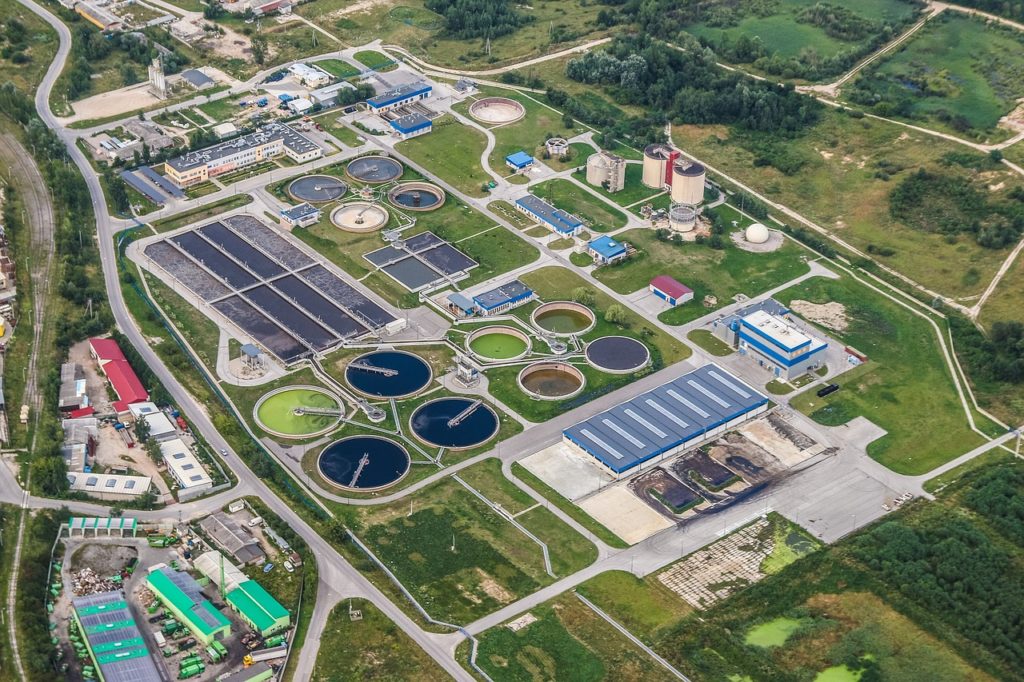Wastewater treatment is a crucial process that ensures the protection of our environment and public health. However, it is not without its challenges. In this article, you will discover seven common problems that wastewater treatment plants often encounter and effective solutions to overcome them. From clogging issues to treating toxic substances, we will guide you through these obstacles to ensure that your wastewater treatment system operates smoothly and efficiently. So get ready to dive into the world of wastewater treatment problem-solving and learn how to keep your plant running at its best!

1. High Levels of Suspended Solids
1.1 Inadequate Screening and Preliminary Treatment
One of the main causes of high levels of suspended solids in wastewater treatment plants is the lack of proper screening and preliminary treatment. When solid materials enter the treatment process without being adequately screened, they can clog pipes and interfere with the efficiency of downstream processes. To address this issue, it is important to install effective screening mechanisms such as bar screens or drum screens at the inlet of the treatment plant. Additionally, implementing a grit removal system can help to remove heavy particles and improve the overall treatment efficiency.
1.2 Improper Mixing and Flocculation
Improper mixing and flocculation can also contribute to high levels of suspended solids in wastewater treatment. If the mixing process is not optimized, coagulants and flocculants may not be evenly distributed, leading to inadequate flocculation and poor settling of suspended solids. To solve this problem, it is crucial to ensure that mixing equipment is properly calibrated and functioning optimally. Regular maintenance and monitoring of mixing systems can help to prevent issues and ensure efficient flocculation.
1.3 Insufficient Sedimentation Time
Insufficient sedimentation time is another common cause of high levels of suspended solids in wastewater treatment. If the sedimentation basins do not provide enough time for particles to settle, suspended solids may not be effectively removed from the wastewater. To address this issue, it is important to evaluate the design and hydraulic loading of the sedimentation basins. Increasing the sedimentation time or implementing additional clarification processes, such as dissolved air flotation (DAF), can help to improve the removal of suspended solids.
1.4 Inefficient Filtration
Inefficient filtration is another factor that can contribute to high levels of suspended solids in wastewater treatment. If the filtration system is not properly maintained or if the filter media are damaged or clogged, solids can pass through and be discharged with the treated effluent. To solve this problem, regular maintenance and cleaning of filters are essential. It is also important to monitor the performance of the filtration system and replace damaged or worn-out filter media promptly.
1.5 Insufficient Sludge Removal
Another issue that can result in high levels of suspended solids is insufficient sludge removal. If sludge is not effectively removed from the system, it can accumulate and interfere with the settling of suspended solids in the treatment process. To address this problem, proper sludge management practices should be implemented. This includes regular removal of sludge from sedimentation basins and the use of efficient sludge dewatering methods such as centrifugation or belt presses. By effectively managing sludge, the overall treatment process can be optimized, leading to lower levels of suspended solids in the effluent.
2. Excessive Nutrient Load
2.1 Imbalance in Nutrient Removal Processes
Excessive nutrient load in wastewater treatment can lead to environmental issues such as eutrophication in receiving water bodies. An imbalance in nutrient removal processes is often the cause of this problem. Biological nutrient removal (BNR) processes, such as nitrification and denitrification, may not be properly optimized, resulting in the release of excessive nutrients in the treated effluent. To solve this issue, it is important to evaluate the design and operation of the BNR processes. Adjustments should be made to ensure optimal nutrient removal and minimize the discharge of excess nutrients.
2.2 Inadequate Aeration
Inadequate aeration can also contribute to excessive nutrient load in wastewater treatment. Insufficient oxygen levels in the treatment process can hinder the activity of aerobic bacteria responsible for nutrient removal, leading to incomplete treatment and higher nutrient concentrations in the effluent. To address this issue, it is important to optimize the aeration system. This may include upgrading aeration equipment, increasing the oxygen supply, or implementing additional aeration stages to ensure adequate oxygenation and optimal nutrient removal.
2.3 Lack of Secondary Treatment
A lack of secondary treatment can also result in excessive nutrient load in wastewater treatment plants. If the treatment process does not include secondary treatment processes such as activated sludge or biofilm reactors, the removal of nutrients may be limited. To solve this problem, it is crucial to incorporate appropriate secondary treatment processes into the treatment plant design. Implementing these processes can enhance the removal of nutrients and ensure compliance with effluent nutrient standards.
2.4 Insufficient Monitoring and Control
Insufficient monitoring and control of nutrient levels can contribute to excessive nutrient load in wastewater treatment. Without accurate and timely monitoring, it becomes difficult to identify deviations from desired nutrient removal targets. To address this issue, it is important to implement a comprehensive monitoring and control system. This includes regular sampling and analysis of influent and effluent nutrient concentrations, as well as the use of automated control systems to adjust treatment processes based on real-time data. By effectively monitoring and controlling nutrient levels, excessive nutrient load can be minimized.

3. Odor Issues
3.1 Anaerobic Conditions
Odor issues in wastewater treatment plants are often caused by the presence of anaerobic conditions. Anaerobic bacteria produce foul-smelling gases such as hydrogen sulfide during the decomposition of organic matter in the absence of oxygen. To solve this issue, it is important to ensure sufficient aeration in the treatment process to maintain aerobic conditions. This can be achieved by optimizing the aeration system and providing adequate oxygen supply to the biological treatment units. By promoting aerobic conditions, the production of odor-causing gases can be reduced.
3.2 Poor Sludge Management
Poor sludge management practices can also contribute to odor issues in wastewater treatment. If sludge is not properly handled and stored, it can release unpleasant odors. To address this problem, it is important to implement effective sludge management practices. This includes proper storage and containment of sludge, regular maintenance and cleaning of sludge handling equipment, and the use of odor control measures such as covers or biofilters. By implementing good sludge management practices, odor issues can be minimized.
3.3 Ineffective Odor Control Measures
Ineffective odor control measures can also contribute to odor issues in wastewater treatment plants. If the existing odor control measures are not properly designed or maintained, they may not effectively capture or treat the odorous gases. To solve this problem, it is crucial to evaluate and optimize the odor control system. This may involve the installation of additional odor control devices such as activated carbon filters or biofilters, as well as regular maintenance and replacement of the existing odor control equipment.
3.4 Insufficient Ventilation
Insufficient ventilation is another factor that can contribute to odor issues in wastewater treatment. Inadequate airflow within the treatment plant can result in the buildup of odorous gases. To address this issue, it is important to ensure proper ventilation throughout the facility. This may involve the installation of exhaust fans or ductwork to facilitate the movement of air and prevent the accumulation of odorous gases. By improving ventilation, the concentration of odor-causing gases can be reduced, thus minimizing odor issues.
4. High Energy Consumption
4.1 Inefficient Pumping Systems
High energy consumption in wastewater treatment plants can be attributed to inefficient pumping systems. If the pumping equipment is outdated or not properly maintained, it may consume more energy than necessary. To solve this issue, it is important to evaluate the performance of pumping systems and identify opportunities for improvement. Upgrading to more energy-efficient pumps, implementing variable speed drives, and optimizing pump schedules can significantly reduce energy consumption and operating costs.
4.2 Outdated Treatment Technologies
Outdated treatment technologies can also contribute to high energy consumption in wastewater treatment. Older treatment processes may not be as energy-efficient as newer technologies that have been developed to minimize energy usage. To address this problem, it is important to assess the feasibility of upgrading or retrofitting the treatment plant with more energy-efficient technologies. This may include the adoption of advanced biological treatment processes, membrane filtration systems, or energy recovery systems such as anaerobic digestion or biogas generation.
4.3 Lack of Energy Recovery
In wastewater treatment plants, a lack of energy recovery mechanisms can result in high energy consumption. Wastewater contains organic matter that can be converted into energy through anaerobic digestion or other bioenergy processes. To solve this issue, it is important to implement energy recovery systems that capture and utilize this energy. Anaerobic digestion can be employed to produce biogas, which can then be used for heat and electricity generation. By maximizing energy recovery, the overall energy consumption of the treatment plant can be reduced.
4.4 Inadequate System Optimization
Inadequate system optimization can contribute to high energy consumption in wastewater treatment. If the treatment processes and equipment are not properly calibrated or operated, energy may be wasted. To address this problem, it is important to conduct regular system optimization assessments. This includes evaluating the performance of treatment processes, monitoring energy usage, and identifying areas for improvement. By implementing energy management strategies and optimizing system operations, energy consumption can be minimized, leading to cost savings and environmental benefits.

5. Discharge Non-Compliance
5.1 Inaccurate Monitoring and Sampling
Discharge non-compliance occurs when wastewater treatment plants fail to meet effluent quality standards set by regulatory authorities. One of the primary causes of non-compliance is inaccurate monitoring and sampling. If monitoring equipment is not properly calibrated or sampling procedures are not followed correctly, the reported effluent quality may not be accurate. To address this issue, it is crucial to ensure the accuracy and reliability of monitoring and sampling practices. Regular calibration of monitoring equipment, adherence to standard operating procedures, and training of plant operators can help to ensure accurate and representative effluent quality data.
5.2 Failure to Meet Effluent Standards
Failure to meet effluent standards can occur due to various factors within the wastewater treatment process. Inadequate treatment processes, improper operation or maintenance of treatment equipment, and insufficient removal of pollutants can all contribute to non-compliance. To solve this problem, it is important to evaluate the treatment process and identify areas for improvement. This may involve upgrading treatment technologies, optimizing treatment parameters, or implementing additional treatment steps to ensure the desired effluent quality is consistently achieved.
5.3 Poor Effluent Quality Testing
Poor effluent quality testing can also contribute to discharge non-compliance. If the testing methods employed are not accurate or reliable, the reported effluent quality may not reflect the actual levels of pollutants. To address this issue, it is important to implement proper quality control measures for effluent testing. This includes using standardized testing methods, regularly calibrating testing equipment, and conducting proficiency testing to ensure the accuracy and reliability of effluent quality data.
5.4 Insufficient Compliance Reporting
Insufficient compliance reporting can lead to non-compliance in wastewater treatment plants. If required reports are not submitted in a timely manner or if the information provided is incomplete or inaccurate, regulatory authorities may consider the plant to be non-compliant. To solve this problem, it is crucial to establish a robust compliance reporting system. This includes ensuring that all required reports are prepared accurately and submitted within the specified timelines. Regular training and internal audits can help to ensure compliance reporting requirements are consistently met.
6. Aging Infrastructure
6.1 Deteriorating Pipes and Tanks
Aging infrastructure is a common challenge in wastewater treatment plants, with deteriorating pipes and tanks being a significant concern. As pipes and tanks age, they may develop leaks, cracks, or corrosion, leading to inefficiencies and potential environmental hazards. To address this issue, it is important to prioritize the maintenance and repair of aging infrastructure. Regular inspections, proactive maintenance programs, and timely repairs or replacements of deteriorated pipes and tanks can help to ensure the integrity of the treatment system and prevent costly and disruptive failures.
6.2 Outdated Equipment and Controls
Outdated equipment and controls can also contribute to challenges associated with aging infrastructure. Older equipment may not operate as efficiently as newer technologies and may be more prone to breakdowns. Additionally, outdated control systems may not provide the necessary level of automation and data monitoring required for optimal plant performance. To solve this problem, it is important to assess the condition and performance of equipment and controls. Upgrading outdated equipment and implementing modern control systems can improve reliability, efficiency, and overall plant performance.
6.3 Inadequate Maintenance and Inspections
Inadequate maintenance and inspections are common issues in aging wastewater treatment infrastructure. Without regular and proactive maintenance, the condition of infrastructure components may deteriorate more rapidly. Additionally, the lack of periodic inspections can result in undetected issues that can lead to costly repairs or failures. To address this problem, it is crucial to establish comprehensive maintenance and inspection programs. Conducting routine inspections, implementing preventive maintenance schedules, and promptly addressing identified maintenance needs can significantly extend the lifespan of aging infrastructure.
6.4 Lack of Asset Management System
A lack of an asset management system is another challenge associated with aging infrastructure. Without a system in place to track the condition and performance of infrastructure assets, it becomes difficult to prioritize maintenance and replacement efforts effectively. To solve this problem, it is important to implement an asset management system that allows for the systematic monitoring and evaluation of infrastructure assets. This includes maintaining an inventory of assets, conducting condition assessments, and utilizing data-driven decision-making processes to prioritize maintenance, repairs, and replacements.
7. Contaminant Spills and Accidents
7.1 Inadequate Spill Prevention Measures
Contaminant spills and accidents can result in environmental damage and pose risks to human health. One of the main causes of such incidents is inadequate spill prevention measures. If proper containment and spill response procedures are not in place, accidental spills may not be contained or addressed promptly, leading to contamination of the surrounding environment. To address this issue, it is crucial to establish comprehensive spill prevention measures. This includes implementing robust containment systems, conducting regular inspections, and training staff on proper spill response protocols.
7.2 Improper Chemical Storage and Handling
Improper chemical storage and handling practices can also contribute to contaminant spills and accidents. If chemicals used in the treatment process are not stored, handled, or transported correctly, the risk of accidental spills and releases increases substantially. To solve this problem, it is important to establish proper chemical storage and handling protocols. This includes storing chemicals in designated areas, using appropriate containment systems, and ensuring that staff is trained in safe chemical handling practices. By implementing effective chemical management procedures, the risk of spills and accidents can be significantly reduced.
7.3 Insufficient Emergency Response Planning
Insufficient emergency response planning is another factor that can contribute to contaminant spills and accidents. If a wastewater treatment plant does not have a well-defined and regularly updated emergency response plan, staff may be ill-prepared to handle unforeseen incidents effectively. To address this issue, it is crucial to develop and implement a comprehensive emergency response plan. This includes identifying potential risks and hazards, establishing clear roles and responsibilities, conducting regular drills and training exercises, and maintaining effective communication channels with relevant stakeholders. By having a well-prepared and practiced emergency response plan, the impact of contaminant spills and accidents can be minimized.
7.4 Lack of Regular Training and Drills
A lack of regular training and drills can also contribute to challenges related to contaminant spills and accidents. If staff members are not adequately trained in spill response procedures or if drills are not conducted regularly, the ability to effectively respond to incidents may be compromised. To solve this problem, it is important to prioritize training and preparedness efforts. This includes providing comprehensive training on spill response protocols, ensuring that staff members are familiar with the location and use of spill response equipment, and conducting regular drills to practice emergency response procedures. By investing in training and preparedness, the ability to prevent and mitigate contaminant spills and accidents can be significantly improved.
In conclusion, wastewater treatment plants face a range of common challenges that can impact their efficiency and compliance with regulatory standards. By addressing issues such as high levels of suspended solids, excessive nutrient load, odor problems, high energy consumption, discharge non-compliance, aging infrastructure, and contaminant spills and accidents, these plants can optimize their performance and minimize their impact on the environment. Implementing appropriate solutions, such as improving screening and preliminary treatment, optimizing treatment processes, implementing odor control measures, upgrading equipment and controls, implementing energy recovery systems, enhancing monitoring and sampling practices, prioritizing maintenance and inspections, and establishing effective emergency response plans, can help to overcome these challenges and ensure the effective and sustainable operation of wastewater treatment plants.



